Search Result
Results for "
quenched
" in MedChemExpress (MCE) Product Catalog:
2
Biochemical Assay Reagents
| Cat. No. |
Product Name |
Target |
Research Areas |
Chemical Structure |
-
- HY-P2536
-
-
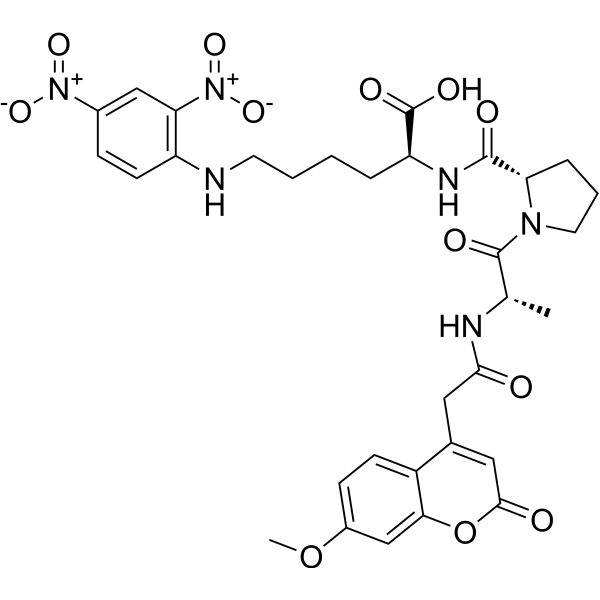
-
- HY-D1045
-
|
DABCYL; Para-methyl red
|
Fluorescent Dye
|
Others
|
|
Dabcyl acid (Dabcyl) is the original dark fluorescence quencher.
|
-

-
- HY-D1663
-
|
|
Fluorescent Dye
|
Others
|
|
APTAB is a fluorescent cationic membrane probe. APTAB locates the anthracene-labeled molecules incorporated into model membranes by fluorescence quenching .
|
-

-
- HY-D1045A
-
|
DABCYL sodium; Para-methyl red sodium
|
Fluorescent Dye
|
Others
|
|
Dabcyl acid sodium (DABCYL sodium) is a nonfluorescent chromophore and a quencher. Dabcyl acid sodium can be used as molecular beacon nucleic acid probes to recognize and report the presence of specific nucleic acids in homogeneous solutions .
|
-
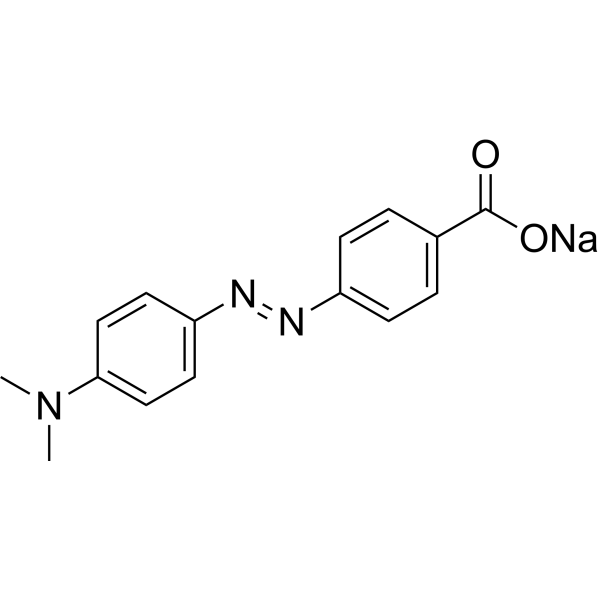
-
- HY-149931
-
|
|
Fluorescent Dye
|
Cancer
|
|
BMV109 is a quenched probe that becomes fluorescent when cleaved and covalently bound by active cathepsin proteases. BMV109 can be exploited for tumor imaging .
|
-
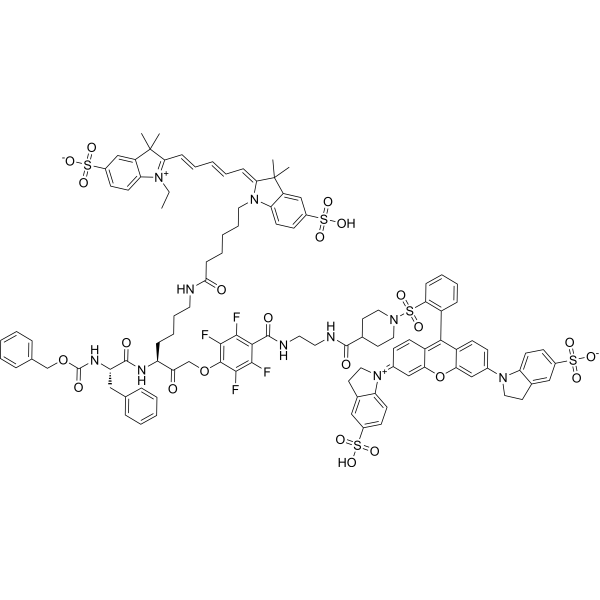
-
- HY-123630
-
|
FD&C RED NO. 40; CI 16035
|
Fluorescent Dye
|
Others
|
Allura Red AC, a food colourant, is dark red and water-soluble powder or granules used in various applications, such as in drinks, syrups, sweets and cereals. Allura Red AC has the ability to quench the intrinsic fluorescence of HSA through static quenching .
|
-
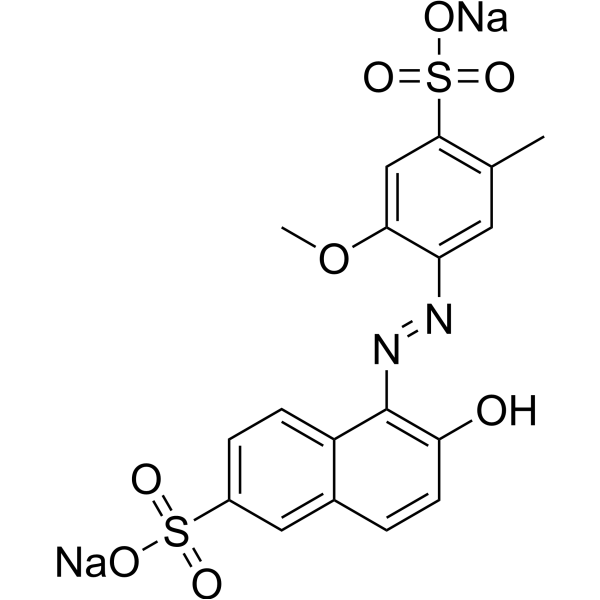
-
- HY-117245
-
-

-
- HY-P4931
-
|
Mca-Lys-Pro-Leu-Gly-Leu-Dpa-Ala-Arg-NH2
|
MMP
|
Cancer
|
|
Mca-Lys-Pro-Leu-Gly-Leu-Dap(Dnp)-Ala-Arg-NH2 (FS-6) is a fluorescent peptide that is a quenched MMP peptide substrate. Mca-Lys-Pro-Leu-Gly-Leu-Dap(Dnp)-Ala-Arg-NH2 can be used for real-time quantification of MMP enzymatic activity. Mca-Lys-Pro-Leu-Gly-Leu-Dap(Dnp)-Ala-Arg-NH2 is an elongated peptide of MMP substrate (FS-1) and is active against collagenases (MMP-1, MMP-8, MMP-13 ) and MT1-MMP with higher specificity constants than FS-1 . (Ex/Em=325 nm/400 nm)
|
-
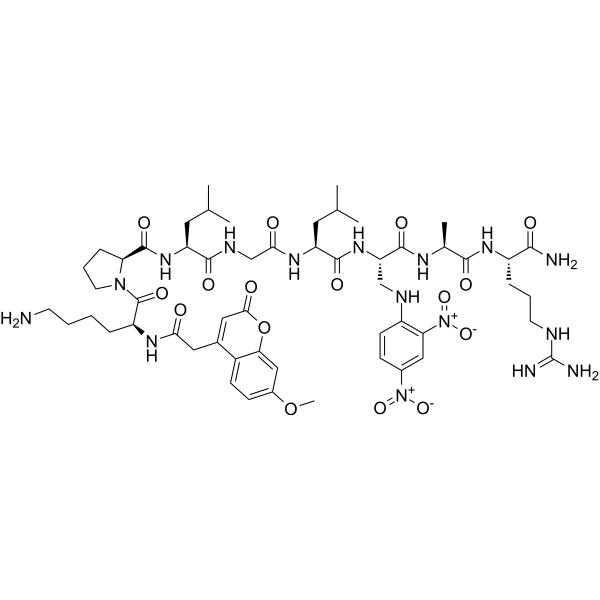
-
- HY-D1080
-
EDANS
1 Publications Verification
1,5-EDANS
|
Fluorescent Dye
|
Others
|
|
EDANS (1,5-EDANS) is a novel and quenched fluorogenic substrate for assaying retroviral protease by resonance energy transfer (RET) .
|
-
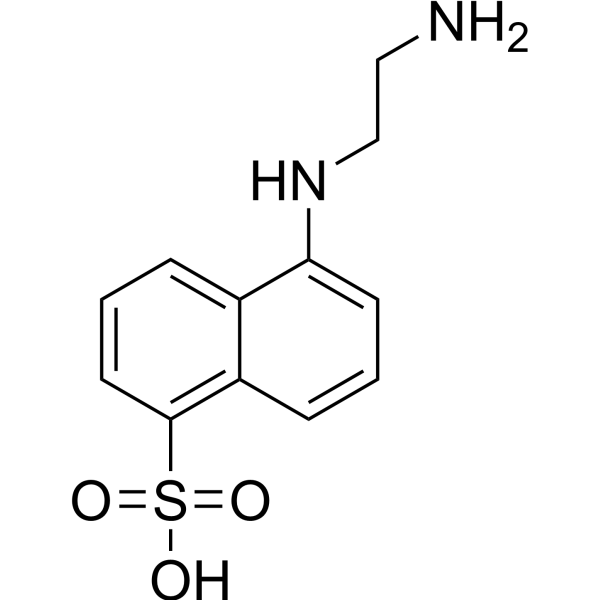
-
- HY-153770
-
-

-
- HY-P4920
-
|
|
Fluorescent Dye
|
Others
|
|
Mca-SEVNLDAEFK(Dnp)-NH2 contains a highly fluorescent 7-methoxycoumarin group that is efficiently quenched by resonance energy transfer to the 2,4-dinitrophenyl group. It can be used to measure the activities of peptidases that are capable of cleaving an amide bond between the fluorescent group and the quencher group, causing an increase in fluorescence, such as can be used to measure the activity of BACE-1 .
|
-
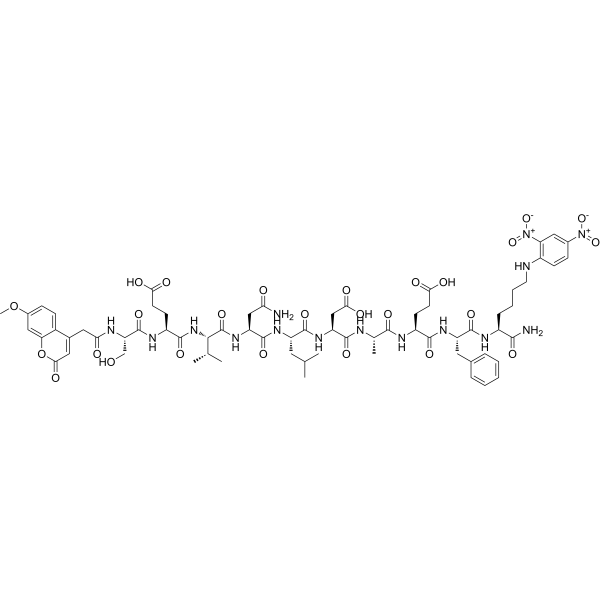
-
- HY-D0040
-
Calcein
4 Publications Verification
Fluorexon
|
Fluorescent Dye
|
Others
|
|
Calcein is a fluorescent dye and self-quenching probe, used as an indicator of lipid vesicle leakage, and also as a complexometric indicator for titration of calcium ions with EDTA, and for fluorometric determination of calcium.
|
-

-
- HY-P1853
-
-
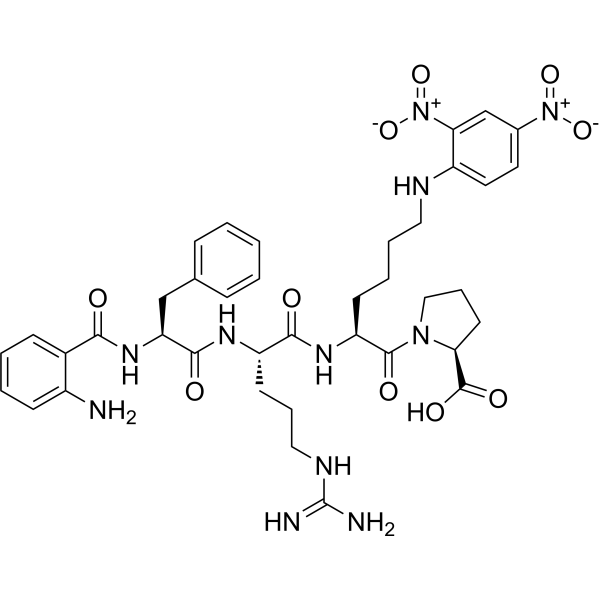
-
- HY-D1030
-
|
|
Fluorescent Dye
|
Inflammation/Immunology
|
|
Fluorescein Biotin is used as an alternative to radioactive biotin for detecting and quantitating biotin-binding sites by either fluorescence or absorbance; the the fluorescence or absorbance of Fluorescein Biotin is quenched, upon binding to avidin or streptavidin.
|
-
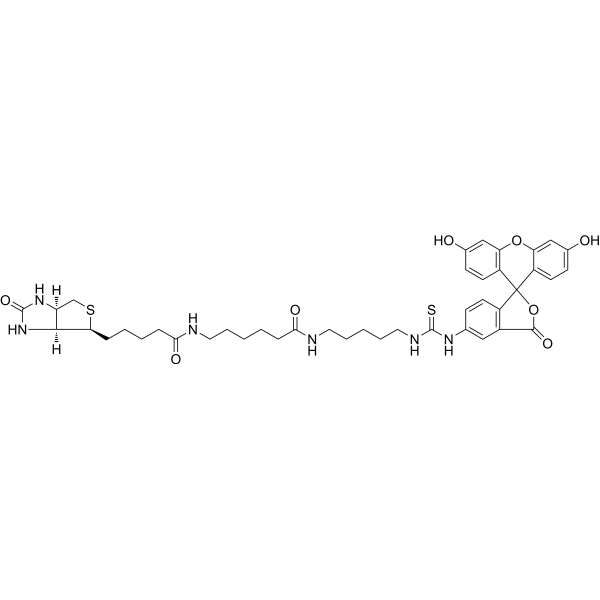
-
- HY-P4919
-
|
|
Beta-secretase
|
Others
|
|
Mca-SEVNLDAEFK(Dnp) is a Beta-secretase 1 (BACE-1) peptide FRET substrate, containing the 'Swedish' Lys-Met/Asn-Leu mutation of the amyloid precursor protein (APP) β-secretase cleavage site. Cleavage at -Leu-Asp- of Mca-SEVNLDAEFK(Dnp) liberates the highly fluorescent 7-methoxycoumarin (Mca) fragment from the proximity quenching effect of the 2,4-dinitrophenyl (Dnp) internal quencher resulting in a large and easily detectable increase in fluorescence intensity.
|
-
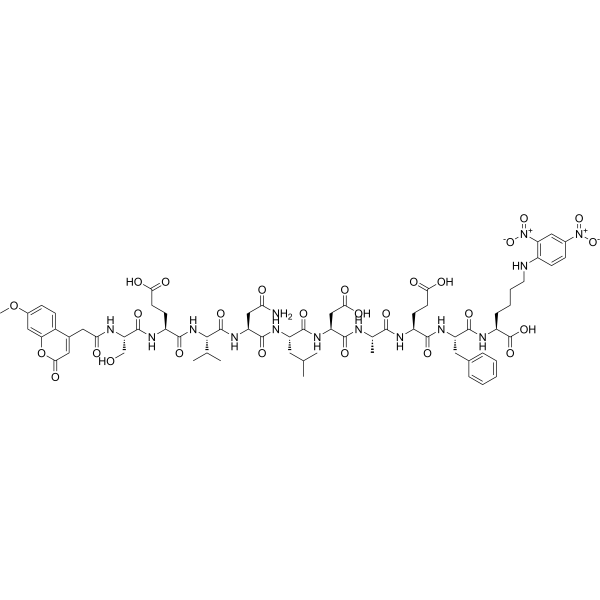
-
- HY-W012642A
-
|
|
DNA Stain
|
Others
|
|
2-Aminopurine dihydrochloride is a fluorescent analog of guanosine. 2-Aminopurine dihydrochloride can be used as a fluorescence probe for nucleic acid structure and dynamics. Incorporating 2-Aminopurine dihydrochloride into DNA quenches its fluorescence .
|
-
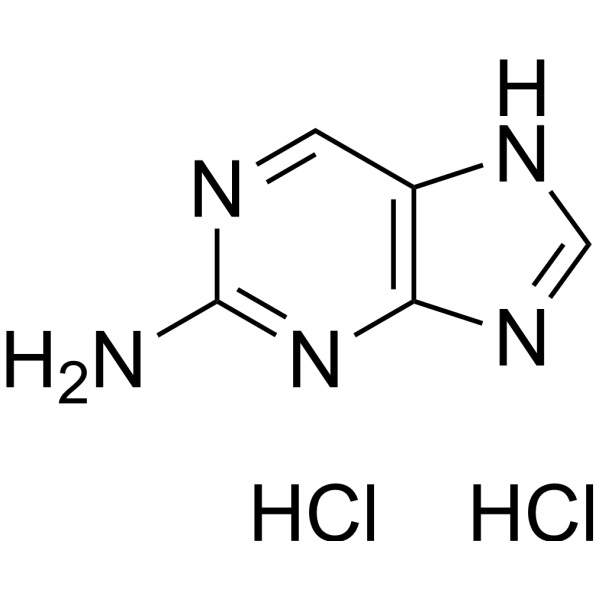
-
- HY-118213
-
|
|
Fluorescent Dye
|
Others
|
|
N-(2-Hydroxyethyl)-1,8-naphthalimide is a fluorescent probe for detecting nucleic acids and their precursors. The fluorescence of N-(2-Hydroxyethyl)-1,8-naphthalimide will be quenched by these molecules.
|
-
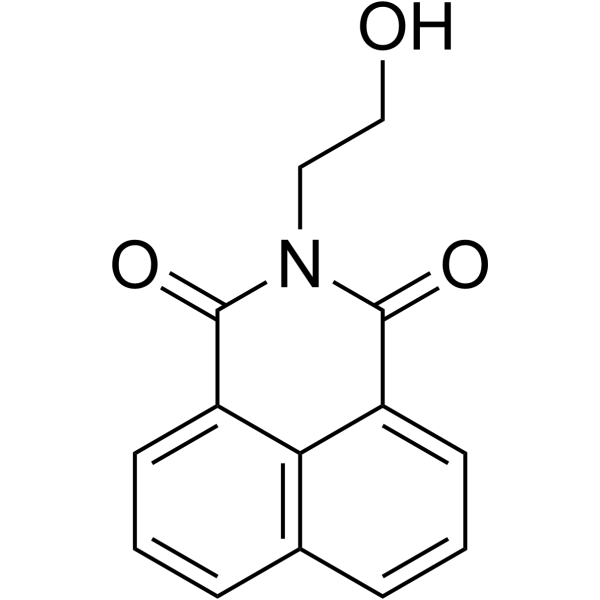
-
- HY-163204
-
|
|
P-glycoprotein
|
Cancer
|
|
RhQ-DMB is a potent inhibitor of P-gp. RhQ-DMB exhibits high affinity and inhibitory activity in yeast strains expressing CmABCB1 .
|
-
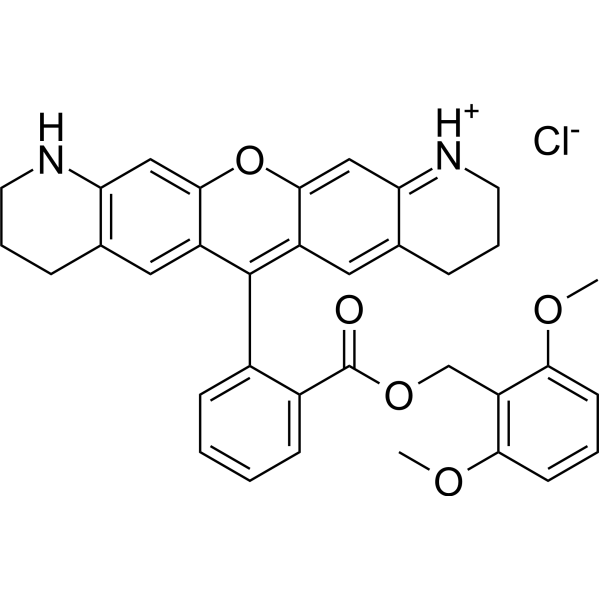
-
- HY-D1049
-
|
6-((2,4-Dinitrophenyl)amino)hexanoic acid
|
Fluorescent Dye
|
Metabolic Disease
|
|
DNP-X acid (6-((2,4-Dinitrophenyl)amino)hexanoic acid), an amine-reactive building block for developing a probe, can be recognized by anti-DNP antibodies. DNP-X acid is also an excellent amine-reactive FRET quencher paired with Trp or Tyr.
|
-

-
- HY-P10163
-
|
|
Fluorescent Dye
|
Others
|
|
α-Secretase Substrate II, Fluorogenic is an internally quenched fluorogenic peptide substrate for α-Secretase that contains the α-secretase cleavage site of β-Amyloid precursor protein (APP) .Ex/Em = 340/490 nm
|
-
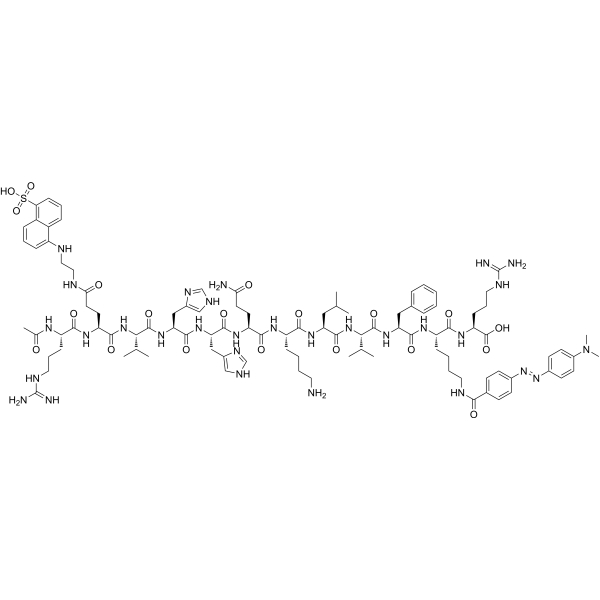
-
- HY-155786
-
|
|
TGF-beta/Smad
|
Others
|
|
3,7-DMF is an orally active inhibitor of TGF-β1-induced activation of HSCs. 3,7-DMF induces antioxidant genes and quenches ROS away, which can be used to study liver fibrosis .
|
-

-
- HY-D0720
-
|
NSC-151912; L-6868
|
Fluorescent Dye
Reactive Oxygen Species
|
Others
|
|
Lucigenin is a chemiluminescence probe. Lucigenin can be used to detect the production of endogenous superoxide anion radical (O 2-). Lucigenin is extremely sensitive to chloride ions, while it combined with chloride ions, the fluorescence will be quenched. Lucigenin also can be used as a chloride indicator. Ex/Em=455/505 nm .
|
-

-
- HY-118159
-
|
DPPP
|
Reactive Oxygen Species
|
Others
|
|
Diphenyl-1-pyrenylphosphine (DPPP) is a fluoregenic peroxide reactive probe. Diphenyl-1-pyrenylphosphine exhibits a unique phototriggered aggregation-induced emission (AIE)/aggregation-induced quenching (ACQ) transition with a remarkable third-order nonlinear optical signal change .
|
-
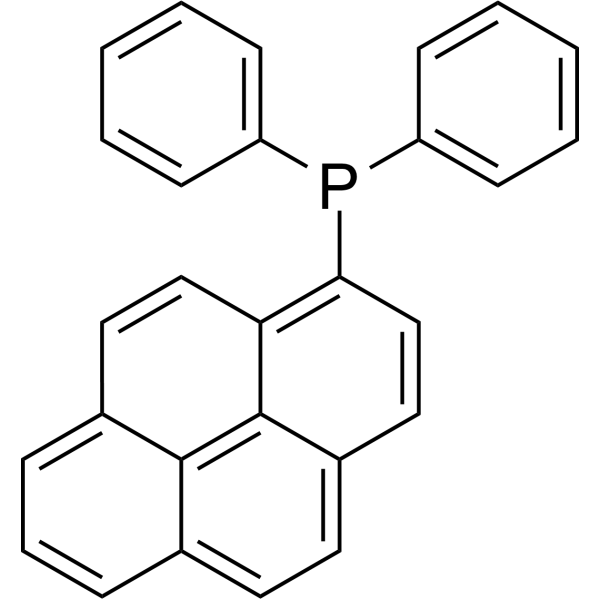
-
- HY-126823
-
|
PGSK diacetate (5/6-mixture)
|
Fluorescent Dye
|
Others
|
|
Phen green SK (PGSK) diacetate is a fluorescent heavy metal indicator that reacts with a variety of metal ions, including Fe2+, Cd2+, Co2+, Ni2+, Zn2+. PGSK diacetate displays excitation/emission maxima of 507/532 nm, respectively, and fluorescence is quenched upon interaction with metal ions
|
-
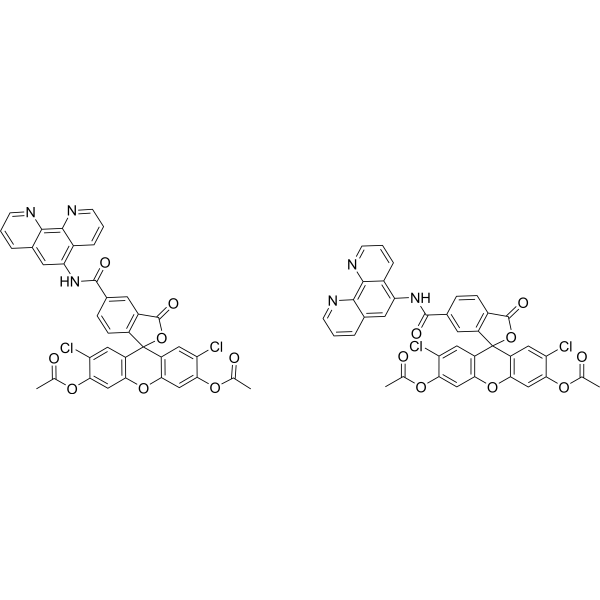
-
- HY-W012642
-
|
|
DNA Stain
|
Others
|
|
2-Aminopurine, a fluorescent analog of guanosine and adenosine, is a widely used fluorescence-decay-based probe of DNA structure. When 2-Aminopurine is inserted in anoligonucleotide, its fluorescence is highly quenched by stacking with the natural bases. 2-Aminopurine has been used to probe nucleic acid structure and dynamics .
|
-

-
- HY-43520
-
|
|
Fluorescent Dye
|
Others
|
|
BODIPY-FL is a potent fluorescent dye. BODIPY-FL can be used to label probe or primer for fluorescent quenching-based quantitative detection of specific DNA/RNA.BODIPY-FL-labeled monoterpenoid can be used to examine the features of a broad spectrum of Gram-positive and Gram-negative bacteria and pathogenic fungi as well .
|
-

-
- HY-D1682
-
|
|
Fluorescent Dye
|
Others
|
|
NFQ1 is a non-fluorescent quencher (absorption wavelength: 474 nm), and is used for a new type of One Sample Fluorescence Resonance Energy Transfer (OS-FRET) method. OS-FRET enable measurement of unquenched donor emission in the same sample. NFQ1 shows broad absorption spectrum ensuring its utility as a dark acceptor for many donors .
|
-
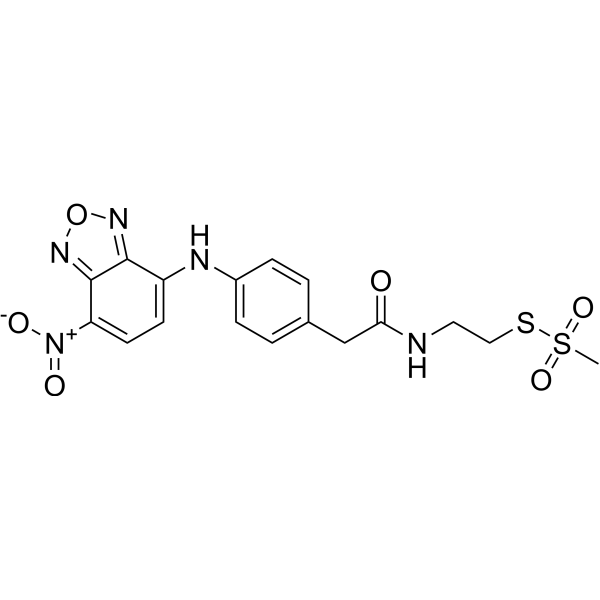
-
- HY-D1050
-
|
6-(2,4-Dinitrophenyl)aminohexanoic acid, succinimidyl ester
|
Fluorescent Dye
|
Metabolic Disease
|
|
DNP-X, SE (6-(2,4-Dinitrophenyl)aminohexanoic acid, succinimidyl ester), the DNP-X acid modified by succinimidyl ester, is an amine-reactive building block for developing a probe, which can be recognized by anti-DNP antibodies. DNP-X, SE (6-(2,4-Dinitrophenyl)aminohexanoic acid, succinimidyl ester) is also an excellent amine-reactive FRET quencher paired with Trp or Tyr.
|
-
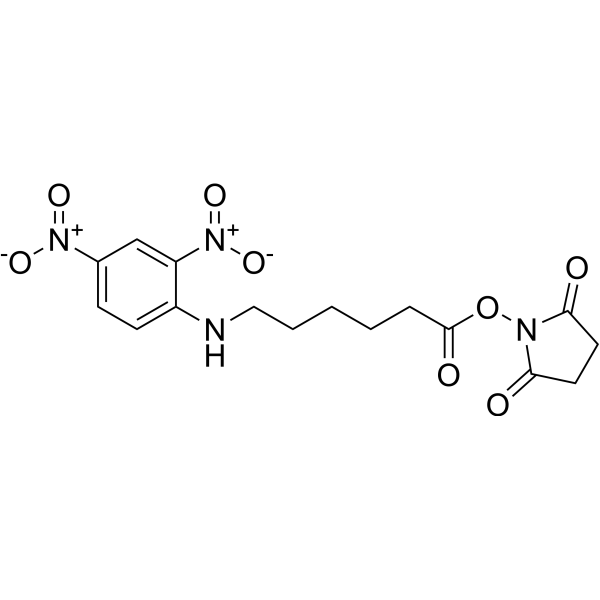
-
- HY-P1883
-
|
|
Fluorescent Dye
|
Infection
|
|
Bacterial Sortase Substrate III, Abz/DNP is an internally quenched fluorescent peptide substrate. Staphylococcus aureus transpeptidase sortase A (SrtA) reacts with its native substrate Bacterial Sortase Substrate III, Abz/DNP, cleaving it and catalyzing the formation of an amide bond between the carboxyl group of threonine and the amino group of cell-wall crossbridges. Cleavage of this substrate can be monitored at Ex/Em=320 nm/420 nm.
|
-

-
- HY-P3749
-
|
|
Fluorescent Dye
|
Others
|
|
Mca-(ala7,lys(dnp)9)-bradykinin is a sensitive fluorogenic substrate for ECE-1 (endothelin-converting enzyme-1). The incorporation of a (7-methoxycoumarin-4-yl)acetyl (Mca) fluorescent group and a 2,4-dinitrophenyl (Dnp) quenching group has resulted in a large fluorescence increase upon substrate cleavage .
|
-

-
- HY-P1883A
-
|
|
Fluorescent Dye
|
Infection
|
|
Bacterial Sortase Substrate III, Abz/DNP TFA is an internally quenched fluorescent peptide substrate. Staphylococcus aureus transpeptidase sortase A (SrtA) reacts with its native substrate Bacterial Sortase Substrate III, Abz/DNP, cleaving it and catalyzing the formation of an amide bond between the carboxyl group of threonine and the amino group of cell-wall crossbridges. Cleavage of this substrate can be monitored at Ex/Em=320 nm/420 nm.
|
-
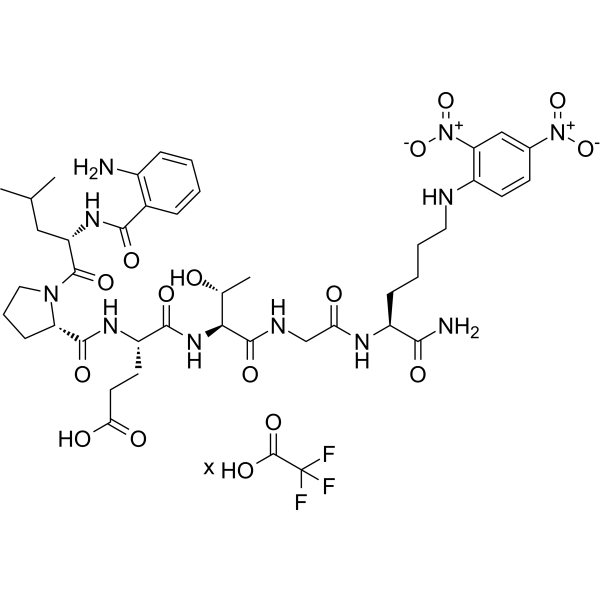
-
- HY-D1590
-
|
|
Fluorescent Dye
|
Others
|
|
ODIPY Green 8-P2M is a novel thiol-reactive fluorescence probe based on the BODIPY fluorophore, the fluorescence is strongly quenched by d-PeT and then can be restored after reaction with thiol, resulting in an extremely high signal-to-noise ratio. ODIPY Green 8-P2M can be useful for detecting extremely low concentrations of protein in the gel after SDS-PAGE .
|
-
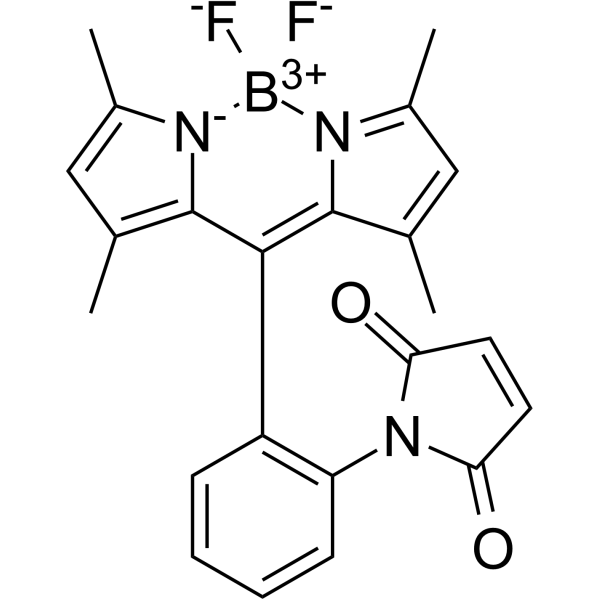
-
- HY-W142692
-
|
|
Biochemical Assay Reagents
|
Others
|
|
Dodecyl β-D-glucopyranoside is a non-ionic detergent and surfactant commonly used to solubilize and purify membrane proteins in biochemical research. Dodecyl β-D-glucopyranoside also interacts with bovine serum albumin (BSA) to quench its intrinsic fluorescence. The critical micelle concentration (CMC) of Dodecyl β-D-glucopyranoside (DG) and DG/BSA complex is 2.0 mM and 2.34 mM, respectively. Micelles can be formed in aqueous solutions above this concentration .
|
-
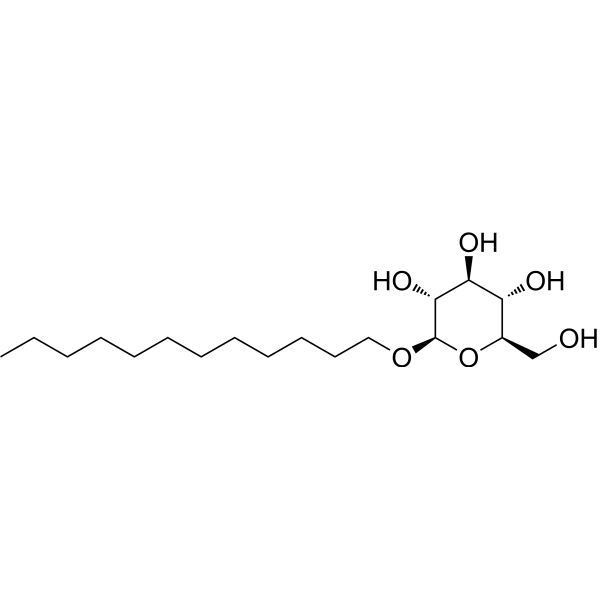
-
- HY-160062
-
|
|
Mucin
|
Cancer
|
|
S2.2 aptamer sodium is a nucleic acid aptamer targeting the mucin MUC1 and can be used for targeted imaging of MCF-7 cancer cells. S2.2 aptamer sodium was labeled with Cy5, and when fluorescent silicon nanodots (SiND) were present, the fluorescence was quenched; when MUC1 was also present, the fluorescence was restored. S2.2 aptamer sodium detects MUC1 with a linear range of 3.33-250 nM .
|
-

-
- HY-D2204
-
|
|
Phosphatase
Fluorescent Dye
|
Cancer
|
|
SHP1-IN-1 (compound 5p) is a fluorescent probe for the protein tyrosine phosphatase SHP1 containing the Src homology 2 domain. SHP1-IN-1 has SHP1 inhibitory activity, selectivity for Fe 3+ ions and good fluorescence properties. SHP1-IN-1 exhibits aggregation post-quenching (ACQ) effect, good interference immunity and low detection limit (5.55 μM) .
|
-
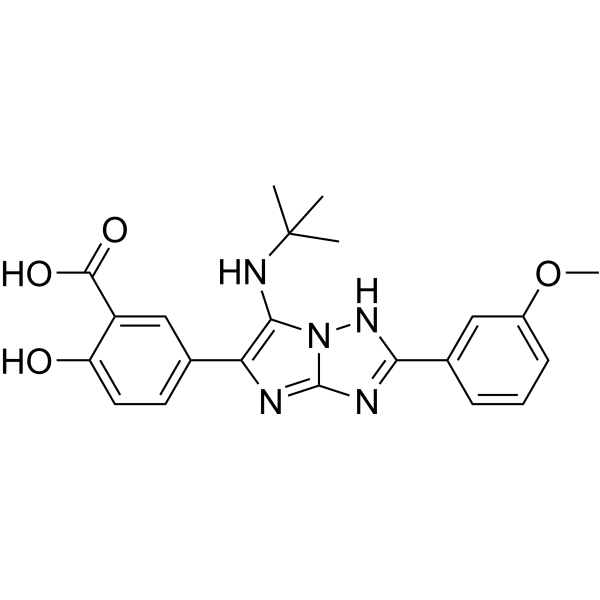
-
- HY-W127716
-
|
|
Fluorescent Dye
|
Cancer
|
|
Ru(bpy)2(mcbpy-O-Su-ester)(PF6)2 is a potent ruthenium-based dye. Ru(bpy)2(mcbpy-O-Su-ester)(PF6)2 can bu used as an effective quencher of quantum dots (QDs) fluorescence and the capture probe of virus antigen EV71. Ru(bpy)2(mcbpy-O-Su-ester)(PF6)2 can be used sensitive electrogenerated chemiluminescence (ECL) labels for detection of matrix metalloproteinases (MMPs) .
|
-
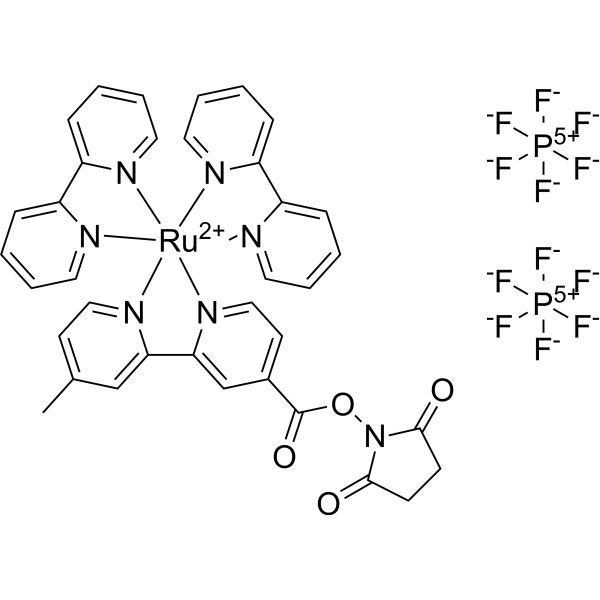
-
- HY-116762
-
|
|
Biochemical Assay Reagents
|
Others
|
|
Quorum sensing is a regulatory system used by bacteria to control gene expression in response to increased cell density. The control of bacterial infection by quenching the quorum sensing system of bacteria is a promising research area. The expression of specific target genes, such as transcriptional regulators belonging to the LuxIR protein family, is coordinated by the synthesis of diffusible acyl homoserine lactone (AHL) molecules. N-butyryl-L-Homocysteine thio-lactone is an analog of N-butyryl-L-homoserine lactone, a small, diffusible signaling molecule involved in quorum sensing, thereby controlling gene expression and cellular metabolism . N-butyryl-L-homocysteine thiolactone induces violacein expression in Viola viola mutants that normally fail to produce AHL.
|
-

| Cat. No. |
Product Name |
Type |
-
- HY-P2536
-
|
|
Fluorescent Dyes/Probes
|
|
Mca-Ala-Pro-Lys(Dnp)-OH, a specific ACE2 quenched fluorogenic substrate, can be used to detect ACE2 activity, such as urinary, heart and lung .
|
-
- HY-D1045
-
-
- HY-123630
-
|
FD&C RED NO. 40; CI 16035
|
Dyes
|
Allura Red AC, a food colourant, is dark red and water-soluble powder or granules used in various applications, such as in drinks, syrups, sweets and cereals. Allura Red AC has the ability to quench the intrinsic fluorescence of HSA through static quenching .
|
-
- HY-D1080
-
EDANS
1 Publications Verification
1,5-EDANS
|
Fluorescent Dyes/Probes
|
|
EDANS (1,5-EDANS) is a novel and quenched fluorogenic substrate for assaying retroviral protease by resonance energy transfer (RET) .
|
-
- HY-D1045A
-
|
DABCYL sodium; Para-methyl red sodium
|
Fluorescent Dyes/Probes
|
|
Dabcyl acid sodium (DABCYL sodium) is a nonfluorescent chromophore and a quencher. Dabcyl acid sodium can be used as molecular beacon nucleic acid probes to recognize and report the presence of specific nucleic acids in homogeneous solutions .
|
-
- HY-D0040
-
Calcein
4 Publications Verification
Fluorexon
|
Fluorescent Dyes/Probes
|
|
Calcein is a fluorescent dye and self-quenching probe, used as an indicator of lipid vesicle leakage, and also as a complexometric indicator for titration of calcium ions with EDTA, and for fluorometric determination of calcium.
|
-
- HY-D1030
-
|
|
Fluorescent Dyes/Probes
|
|
Fluorescein Biotin is used as an alternative to radioactive biotin for detecting and quantitating biotin-binding sites by either fluorescence or absorbance; the the fluorescence or absorbance of Fluorescein Biotin is quenched, upon binding to avidin or streptavidin.
|
-
- HY-W012642A
-
|
|
Fluorescent Dyes/Probes
|
|
2-Aminopurine dihydrochloride is a fluorescent analog of guanosine. 2-Aminopurine dihydrochloride can be used as a fluorescence probe for nucleic acid structure and dynamics. Incorporating 2-Aminopurine dihydrochloride into DNA quenches its fluorescence .
|
-
- HY-118213
-
|
|
Fluorescent Dyes/Probes
|
|
N-(2-Hydroxyethyl)-1,8-naphthalimide is a fluorescent probe for detecting nucleic acids and their precursors. The fluorescence of N-(2-Hydroxyethyl)-1,8-naphthalimide will be quenched by these molecules.
|
-
- HY-D1049
-
|
6-((2,4-Dinitrophenyl)amino)hexanoic acid
|
Fluorescent Dyes/Probes
|
|
DNP-X acid (6-((2,4-Dinitrophenyl)amino)hexanoic acid), an amine-reactive building block for developing a probe, can be recognized by anti-DNP antibodies. DNP-X acid is also an excellent amine-reactive FRET quencher paired with Trp or Tyr.
|
-
- HY-D0720
-
|
NSC-151912; L-6868
|
Fluorescent Dyes/Probes
|
|
Lucigenin is a chemiluminescence probe. Lucigenin can be used to detect the production of endogenous superoxide anion radical (O 2-). Lucigenin is extremely sensitive to chloride ions, while it combined with chloride ions, the fluorescence will be quenched. Lucigenin also can be used as a chloride indicator. Ex/Em=455/505 nm .
|
-
- HY-118159
-
|
DPPP
|
Fluorescent Dyes/Probes
|
|
Diphenyl-1-pyrenylphosphine (DPPP) is a fluoregenic peroxide reactive probe. Diphenyl-1-pyrenylphosphine exhibits a unique phototriggered aggregation-induced emission (AIE)/aggregation-induced quenching (ACQ) transition with a remarkable third-order nonlinear optical signal change .
|
-
- HY-W012642
-
|
|
Fluorescent Dyes/Probes
|
|
2-Aminopurine, a fluorescent analog of guanosine and adenosine, is a widely used fluorescence-decay-based probe of DNA structure. When 2-Aminopurine is inserted in anoligonucleotide, its fluorescence is highly quenched by stacking with the natural bases. 2-Aminopurine has been used to probe nucleic acid structure and dynamics .
|
-
- HY-43520
-
|
|
Fluorescent Dyes/Probes
|
|
BODIPY-FL is a potent fluorescent dye. BODIPY-FL can be used to label probe or primer for fluorescent quenching-based quantitative detection of specific DNA/RNA.BODIPY-FL-labeled monoterpenoid can be used to examine the features of a broad spectrum of Gram-positive and Gram-negative bacteria and pathogenic fungi as well .
|
-
- HY-D1682
-
|
|
Fluorescent Dyes/Probes
|
|
NFQ1 is a non-fluorescent quencher (absorption wavelength: 474 nm), and is used for a new type of One Sample Fluorescence Resonance Energy Transfer (OS-FRET) method. OS-FRET enable measurement of unquenched donor emission in the same sample. NFQ1 shows broad absorption spectrum ensuring its utility as a dark acceptor for many donors .
|
-
- HY-D1050
-
|
6-(2,4-Dinitrophenyl)aminohexanoic acid, succinimidyl ester
|
Fluorescent Dyes/Probes
|
|
DNP-X, SE (6-(2,4-Dinitrophenyl)aminohexanoic acid, succinimidyl ester), the DNP-X acid modified by succinimidyl ester, is an amine-reactive building block for developing a probe, which can be recognized by anti-DNP antibodies. DNP-X, SE (6-(2,4-Dinitrophenyl)aminohexanoic acid, succinimidyl ester) is also an excellent amine-reactive FRET quencher paired with Trp or Tyr.
|
-
- HY-P3749
-
|
|
Fluorescent Dyes/Probes
|
|
Mca-(ala7,lys(dnp)9)-bradykinin is a sensitive fluorogenic substrate for ECE-1 (endothelin-converting enzyme-1). The incorporation of a (7-methoxycoumarin-4-yl)acetyl (Mca) fluorescent group and a 2,4-dinitrophenyl (Dnp) quenching group has resulted in a large fluorescence increase upon substrate cleavage .
|
-
- HY-D2204
-
|
|
Fluorescent Dyes/Probes
|
|
SHP1-IN-1 (compound 5p) is a fluorescent probe for the protein tyrosine phosphatase SHP1 containing the Src homology 2 domain. SHP1-IN-1 has SHP1 inhibitory activity, selectivity for Fe 3+ ions and good fluorescence properties. SHP1-IN-1 exhibits aggregation post-quenching (ACQ) effect, good interference immunity and low detection limit (5.55 μM) .
|
-
- HY-W127716
-
|
|
Fluorescent Dyes/Probes
|
|
Ru(bpy)2(mcbpy-O-Su-ester)(PF6)2 is a potent ruthenium-based dye. Ru(bpy)2(mcbpy-O-Su-ester)(PF6)2 can bu used as an effective quencher of quantum dots (QDs) fluorescence and the capture probe of virus antigen EV71. Ru(bpy)2(mcbpy-O-Su-ester)(PF6)2 can be used sensitive electrogenerated chemiluminescence (ECL) labels for detection of matrix metalloproteinases (MMPs) .
|
| Cat. No. |
Product Name |
Type |
-
- HY-W142692
-
|
|
Biochemical Assay Reagents
|
|
Dodecyl β-D-glucopyranoside is a non-ionic detergent and surfactant commonly used to solubilize and purify membrane proteins in biochemical research. Dodecyl β-D-glucopyranoside also interacts with bovine serum albumin (BSA) to quench its intrinsic fluorescence. The critical micelle concentration (CMC) of Dodecyl β-D-glucopyranoside (DG) and DG/BSA complex is 2.0 mM and 2.34 mM, respectively. Micelles can be formed in aqueous solutions above this concentration .
|
-
- HY-116762
-
|
|
Biochemical Assay Reagents
|
|
Quorum sensing is a regulatory system used by bacteria to control gene expression in response to increased cell density. The control of bacterial infection by quenching the quorum sensing system of bacteria is a promising research area. The expression of specific target genes, such as transcriptional regulators belonging to the LuxIR protein family, is coordinated by the synthesis of diffusible acyl homoserine lactone (AHL) molecules. N-butyryl-L-Homocysteine thio-lactone is an analog of N-butyryl-L-homoserine lactone, a small, diffusible signaling molecule involved in quorum sensing, thereby controlling gene expression and cellular metabolism . N-butyryl-L-homocysteine thiolactone induces violacein expression in Viola viola mutants that normally fail to produce AHL.
|
| Cat. No. |
Product Name |
Target |
Research Area |
-
- HY-P2536
-
-
- HY-P4931
-
|
Mca-Lys-Pro-Leu-Gly-Leu-Dpa-Ala-Arg-NH2
|
MMP
|
Cancer
|
|
Mca-Lys-Pro-Leu-Gly-Leu-Dap(Dnp)-Ala-Arg-NH2 (FS-6) is a fluorescent peptide that is a quenched MMP peptide substrate. Mca-Lys-Pro-Leu-Gly-Leu-Dap(Dnp)-Ala-Arg-NH2 can be used for real-time quantification of MMP enzymatic activity. Mca-Lys-Pro-Leu-Gly-Leu-Dap(Dnp)-Ala-Arg-NH2 is an elongated peptide of MMP substrate (FS-1) and is active against collagenases (MMP-1, MMP-8, MMP-13 ) and MT1-MMP with higher specificity constants than FS-1 . (Ex/Em=325 nm/400 nm)
|
-
- HY-P4920
-
|
|
Fluorescent Dye
|
Others
|
|
Mca-SEVNLDAEFK(Dnp)-NH2 contains a highly fluorescent 7-methoxycoumarin group that is efficiently quenched by resonance energy transfer to the 2,4-dinitrophenyl group. It can be used to measure the activities of peptidases that are capable of cleaving an amide bond between the fluorescent group and the quencher group, causing an increase in fluorescence, such as can be used to measure the activity of BACE-1 .
|
-
- HY-P1853
-
-
- HY-P4940
-
|
|
Peptides
|
Others
|
|
Abz-Val-Asn-Leu-Asp-Ala-Glu-EDDnp is a quenched fluorometric substrate .
|
-
- HY-P4919
-
|
|
Beta-secretase
|
Others
|
|
Mca-SEVNLDAEFK(Dnp) is a Beta-secretase 1 (BACE-1) peptide FRET substrate, containing the 'Swedish' Lys-Met/Asn-Leu mutation of the amyloid precursor protein (APP) β-secretase cleavage site. Cleavage at -Leu-Asp- of Mca-SEVNLDAEFK(Dnp) liberates the highly fluorescent 7-methoxycoumarin (Mca) fragment from the proximity quenching effect of the 2,4-dinitrophenyl (Dnp) internal quencher resulting in a large and easily detectable increase in fluorescence intensity.
|
-
- HY-P4227A
-
|
|
Peptides
|
Metabolic Disease
|
|
WRVYEKC(dnp)ALK tetraTFA contains tryptophan that can be liberated from the dinitrophenol (DNP) quencher by aminopeptidase activity. WRVYEKC(dnp)ALK tetraTFA can be used as a hydrolysis reaction decapeptide substrate .
|
-
- HY-P10163
-
|
|
Fluorescent Dye
|
Others
|
|
α-Secretase Substrate II, Fluorogenic is an internally quenched fluorogenic peptide substrate for α-Secretase that contains the α-secretase cleavage site of β-Amyloid precursor protein (APP) .Ex/Em = 340/490 nm
|
-
- HY-P1883
-
|
|
Fluorescent Dye
|
Infection
|
|
Bacterial Sortase Substrate III, Abz/DNP is an internally quenched fluorescent peptide substrate. Staphylococcus aureus transpeptidase sortase A (SrtA) reacts with its native substrate Bacterial Sortase Substrate III, Abz/DNP, cleaving it and catalyzing the formation of an amide bond between the carboxyl group of threonine and the amino group of cell-wall crossbridges. Cleavage of this substrate can be monitored at Ex/Em=320 nm/420 nm.
|
-
- HY-P3749
-
|
|
Fluorescent Dye
|
Others
|
|
Mca-(ala7,lys(dnp)9)-bradykinin is a sensitive fluorogenic substrate for ECE-1 (endothelin-converting enzyme-1). The incorporation of a (7-methoxycoumarin-4-yl)acetyl (Mca) fluorescent group and a 2,4-dinitrophenyl (Dnp) quenching group has resulted in a large fluorescence increase upon substrate cleavage .
|
-
- HY-P1883A
-
|
|
Fluorescent Dye
|
Infection
|
|
Bacterial Sortase Substrate III, Abz/DNP TFA is an internally quenched fluorescent peptide substrate. Staphylococcus aureus transpeptidase sortase A (SrtA) reacts with its native substrate Bacterial Sortase Substrate III, Abz/DNP, cleaving it and catalyzing the formation of an amide bond between the carboxyl group of threonine and the amino group of cell-wall crossbridges. Cleavage of this substrate can be monitored at Ex/Em=320 nm/420 nm.
|
-
- HY-P5354
-
|
|
Peptides
|
Others
|
|
FRETS-VWF73 is a biological active peptide. (FRETS-VWF73 is a very powerful Fluorescence-Quenching Substrate for the VWF cleaving protease ADAMTS-13. It is commonly used as a useful tool for the rapid measurement of ADAMTS-13 activity in plasma and is a predictive marker for various thrombotic diseases like TPP. Our new substrate FRETS-VWF73 can be easily used with a 96-well format in commercial plate readers.)
|
-
- HY-K1042
-
2 Publications Verification
|
|
MCE AntiFade Mounting Medium can slow the fluorescence quenching of various common fluorescent dyes with simple operation and good anti-fluorescence quenching effect.
|
-
- HY-K1048
-
|
|
|
AntiFade Reagent (with DAPI) is used to slow the fluorescence quenching.
|
-
- HY-K1047
-
|
|
|
AntiFade Mounting Medium (with DAPI) is a sealing reagent used to slow the fluorescence quenching.
|
Your information is safe with us. * Required Fields.
Inquiry Information
- Product Name:
- Cat. No.:
- Quantity:
- MCE Japan Authorized Agent:













































